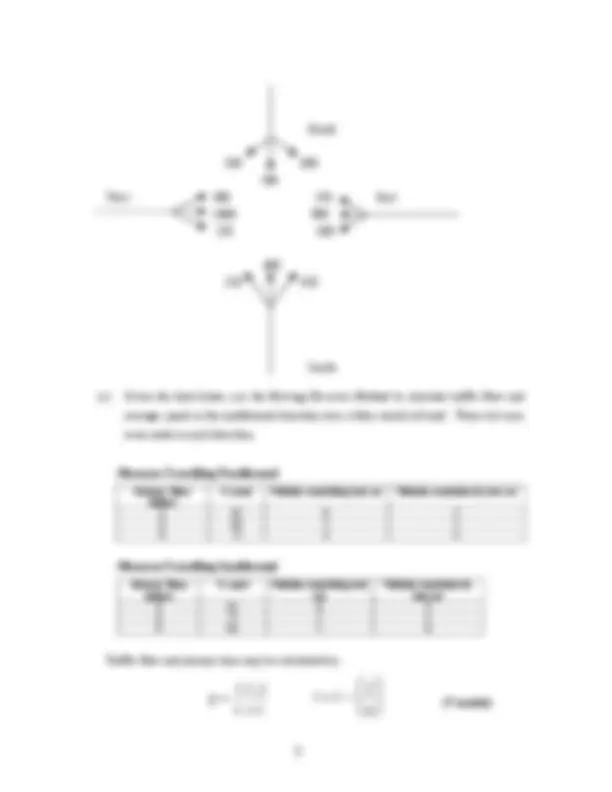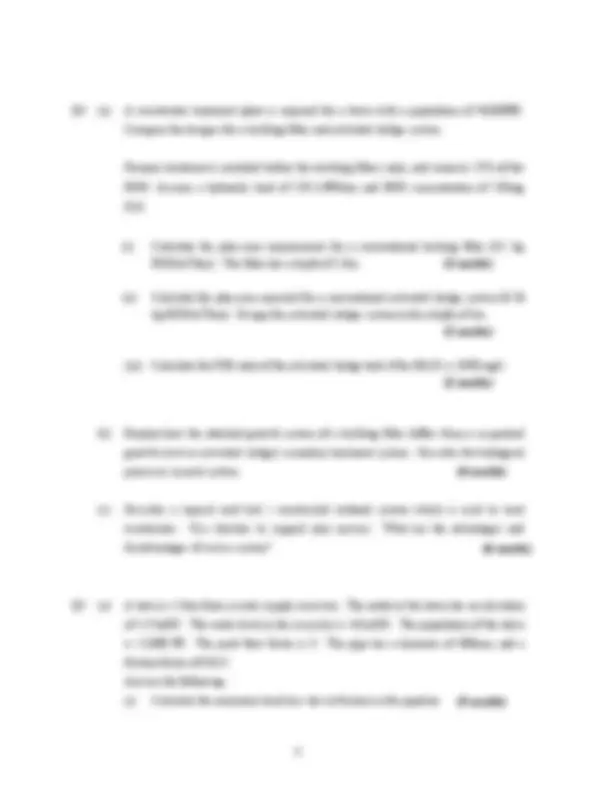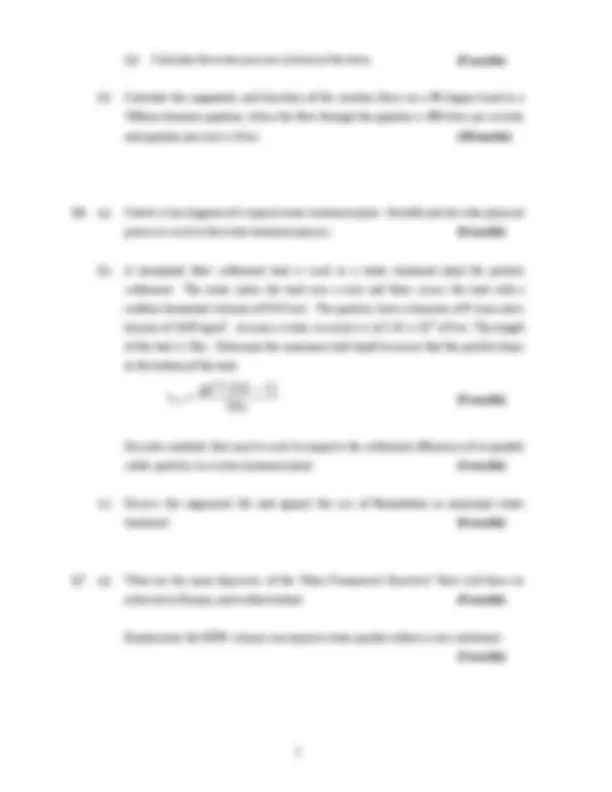





Study with the several resources on Docsity

Earn points by helping other students or get them with a premium plan


Prepare for your exams
Study with the several resources on Docsity

Earn points to download
Earn points by helping other students or get them with a premium plan
Community
Ask the community for help and clear up your study doubts
Discover the best universities in your country according to Docsity users
Free resources
Download our free guides on studying techniques, anxiety management strategies, and thesis advice from Docsity tutors
Main points of this past exam are: Dillon Equation, Rational Equation, Modified Rational Method, Calculate Peak Runoff, Manning’s Roughness Coefficient, Manning’s Equation, Hydrological Terms, Evapotransporation
Typology: Exams
1 / 6

This page cannot be seen from the preview
Don't miss anything!




Instructions Answer 5 questions All questions carry equal marks.
Examiners: Mr. L O’Driscoll Dr. N Power Mr. J. Lapthorne Mr. J. Kindregan
Q1. (a) Calculate the peak runoff from a 250m x 500m car park for a 25 year return period storm, and 60 minute duration. Use the Dillon equation (below) to calculate rainfall intensity. Use the Modified Rational Method to calculate runoff from the catchment areas. Assume 90% runoff from impermeable areas. Cr = 1.3. Cv = PR/100. (4 marks)
Dillon Equation (^35) p^15 t
Rational Equation Q(l/s) = 2.78.C (^) v .Cr. A(ha) I(mm/hr)
Calculate the design slope for a 500mm concrete pipe that drains this area, so that the pipe will be flowing half full at peak flow, using Manning’s Equation as follows: Q = A .R2/3^. S 1/2^ / n The Manning’s roughness coefficient is 0.013. (3 marks)
(b) What hydrological and water quality impacts will be expected in a nearby stream which currently drains the area to be developed in Q1(a) above, following development? Describe at least three sustainable urban drainage methods which may be used to alleviate these impacts. (7 marks)
(c) Explain the following hydrological terms: (i) Evapotransporation (ii) Surface runoff (iii) River hydrograph (6 marks)
Q2 (a) With regard to landfill design, explain the following terms: (i) Methane collection and use (2 marks) (ii) HDPE lining of landfills (2 marks) (iii) Leachate collection and treatment (2 marks) (iv) On-site environmental impact mitigation measures (^) (2 marks)
(b) Describe the waste management hierarchy with reference to municipal solid waste management. How does this relate to the management of construction and demolition waste? (4 marks)
(c) Describe a number of methods that may be used to reduce the amount of biodegradable waste going to landfill. (^) (4 marks)
(d) Describe the statutory landfill site selection process used by local authorities in Ireland. (4 marks)
Q3 (a) Compare manual and mechanical methods used to conduct traffic flow surveys. What are the advantages and disadvantages of each method? (^) (6 marks)
(b) The following traffic flows in pcu/hour were determined at a roundabout, based on traffic flow surveys. Is the roundabout capacity adequate (based on your analysis) given:
11m wide weaving sections, 45 m long in each quadrant, e 1 = 9m, e 2 = 10m
w
w w e Q
, e = e^1 + 2 e^2
(7 marks)
Q4 (a) A wastewater treatment plant is required for a town with a population of 40,000PE. Compare the designs for a trickling filter and activated sludge system.
Primary treatment is included before the trickling filters only, and removes 25% of the BOD. Assume a hydraulic load of 220 L/PE/day and BOD concentration of 250mg O 2 /l.
(i) Calculate the plan area requirements for a conventional tricking filter (0.1 kg BOD/m^3 /day). The filter has a depth of 1.8m. (3 marks)
(ii) Calculate the plan area required for a conventional activated sludge system (0. kg BOD/m^3 /day). Design the activated sludge system with a depth of 4m. (3 marks)
(iii) Calculate the F/M ratio of the activated sludge tank if the MLSS is 3500 mg/l. (2 marks)
(b) Explain how the attached growth system of a trickling filter differs from a suspended growth (such as activated sludge) secondary treatment system. Describe the biological processes in each system. (6 marks)
(c) Describe a typical reed bed / constructed wetland system which is used to treat wastewater. Use sketches to support your answer. What are the advantages and disadvantages of such a system? (^) (6 marks)
Q5 (a) A town is 15km from a water supply reservoir. The outlet at the town has an elevation of +27mOD. The water level in the reservoir is +61mOD. The population of the town is 15,000 PE. The peak flow factor is 3. The pipe has a diameter of 400mm, and a friction factor of 0.015. Answer the following: (i) Calculate the maximum head loss due to friction in the pipeline. (^) (5 marks)
(ii) Calculate the water pressure (in bar) at the town. (^) (5 marks)
(b) Calculate the magnitude and direction of the reaction force on a 90 degree bend in a 500mm diameter pipeline, where the flow through the pipeline is 300 litres per second, and pipeline pressure is 6 bar. (10 marks)
Q6 (a) Sketch a line diagram of a typical water treatment plant. Identify and describe physical processes used in the water treatment process. (6 marks)
(b) A horizontal flow settlement tank is used in a water treatment plant for particle settlement. The water enters the tank over a weir and flows across the tank with a uniform horizontal velocity of 0.015m/s. The particles have a diameter of 0.1mm and a density of 2650 kg/m^3. Assume a water viscosity ( v) of 1.01 x 10-6^ m^2 /sec. The length of the tank is 10m. Determine the maximum tank depth to ensure that the particle drops to the bottom of the tank.
s
(5 marks)
Describe methods that may be used to improve the settlement efficiency of suspended solids particles in a water treatment plant. (3 marks)
(c) Discuss the arguments for and against the use of fluoridation in municipal water treatment. (6 marks)
Q7 (a) What are the main objectives of the Water Framework Directive? How will these be achieved in Europe, and within Ireland. (5 marks)
Explain how the REPS scheme can improve water quality within a river catchment. (3 marks)